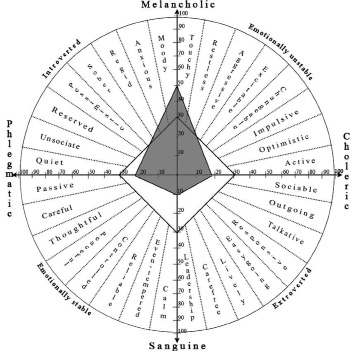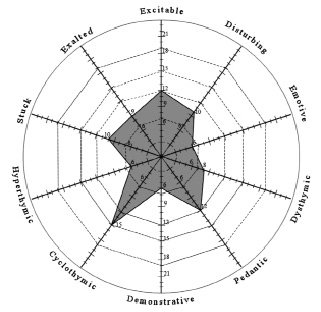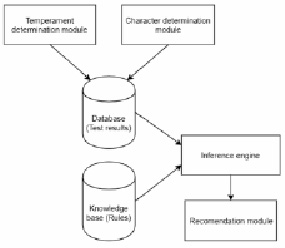The success of a modern enterprise depends largely on the psychological characteristics of its employees. Often there are questions whether the personnel have been correctly selected, whether their basic personal characteristics meet the requirements of the work being done, whether they have the necessary level of knowledge and skills to be effective for the company. It is impossible to answer all the questions when you talk with employees, observing their activities or simply analyzing their past achievements. In such cases, the evaluation of employee performance should begin with a preliminary psychological diagnostic [1].
To simplify and automate the solution of problems associated with effective recruitment, it is proposed to use a psychodiagnostic expert system with a modular structure. The developed expert system consists of three main modules, the joint result of which are recommendations on hiring a job seeker containing preferred activities of the test person, characterization of personality characteristics and possible disorders and deviations from normal states.
The starting point in complex psychological diagnostics is the temperament determination module [2]. In this module A.N. Belov’s method is used, which allows to determine the predominant type of temperament and identify the percentage of different qualities of other types. Tests are performed of 20 questions in 4 blocks for each type of temperament.
After determining the sum of all points (A), the percentage ratio of temperaments is calculated using the formula of A.N. Belov:

where T is the formula of temperament (integral temperament);
А – the total number of points of all types of temperament;
Аh – the total number of points corresponding to the qualities of a choleric;
Аs – the total number of points corresponding to the qualities of a sanguine person;
Аf – the total number of points corresponding to the qualities of a phlegmatic person;
Аm – the total number of points corresponding to the qualities of a melancholic.
Based on the data obtained, the percentage of points for each type of temperament is calculated from the total number of points and the values of variables for choleric, sanguine, phlegmatic and melancholic temperament are formed, respectively.
To visualize the results obtained, a graphic model is constructed showing the relationship between the four classical types of temperaments and the results of modern methods of a factor-analytical description of a person.
Indicators of the type of temperament in percent, obtained according to the formula calculated above, are deposited on the coordinate axes. Distance from the center of the axis indicates the severity of a particular type of temperament. All values of temperament indicators less than 30 % are in an empty quadrangle, reflecting the absence of a severity of one or another type of temperament and corresponding qualities for it.
The second module of the psychodiagnostic expert system is the character determination module, which allows to determine character accentuation and some personality traits which depends on the character [3].
To determine the severity of accentuations is used a method for diagnosing types of character accentuations, published by G. Schmishek and being a modification of the method of studying the accentuations of the personality of K. Leongard [4].

Fig. 1. An example of a graphical model showing the relationship of pronounced temperament types
K. Leonhard identified 10 types of accentuated personalities: demonstrative, pedantic, stuck, excitable, hyperthymic, dysthymic, disturbing, cyclothymic, exalted, emotive [5].
To determine the accentuation test is conducted, consisting of 88 questions. Then the indicators are converted using the appropriate coefficients according to the formula:

where A is the total value;
P – the number of points scored in the test for this type of accentuation;
C – coefficient for this type of accentuation.
The coefficients for each type of accentuation are presented in table.
To visualize the results obtained, a graphical model is constructed showing the relationship between the types of accentuations and the severity of each of them according to the test results.
Coefficients of types of accentuations
|
Type of accentuation |
Coefficient |
|
1. Hyperthymic |
3 |
|
2. Cyclothymic |
3 |
|
3. Exalted |
6 |
|
4. Emotive |
3 |
|
5. Disturbing |
3 |
|
6. Pedantic |
2 |
|
7. Excitable |
3 |
|
8. Demonstrative |
2 |
|
9. Stuck |
2 |
|
10. Dysthymic |
3 |
On the coordinate axes, indicators of expressiveness of the types of accentuations in points, obtained by the formula presented above, are laid. The distance from the center of the axes indicates the severity of one or another type of accentuation.
The lines connecting the obtained points on the axes of the types of accentuations form a figure corresponding to the relationship of the types of accentuations of the character of the person being tested.
The model allows you to graphically display the test results, presenting quantitative indicators of the severity of all types of accentuations on one scheme, and thus visualizing the individual characteristics of a person’s character. The considered example of the scheme is presented in fig. 2.
Along with the modules for determining temperament and character, the joint work of the solver who aggregates their results with the module of the formation of recommendations is of practical interest. Therefore, in the third module, the results of the work of the first two modules are taken and the obtained data is processed, followed by issuing recommendations for choosing a job suitable for a contestant, information and a predisposition to one or another type of work, as well as an extended characteristic of his personality [6].
When the applicant passes the test, the obtained values of temperament and character are recorded in the database. Further data processing takes place dynamically in a solving expert system based on production rules stored in the knowledge base. Then there is a comparison of the results of testing temperament and character with each other, as well as a comparison of the variables responsible for the severity of character traits among themselves, and recommendations are given on how to match the personal qualities of the tested vacant position. The structure of the expert system is presented in fig. 3.
Briefly, the work of the expert system and the sequence of results output can be represented as follows:
1. Identifying individual personal characteristics according to the results of tests of temperament and character. In the intermediate result is determined by the overall characteristics of the job seeker.
2. Establishing of the character’s relationships accentuations and the indicators associated with them.

Fig. 2. An example of a graphical model showing the relationship of certain character accentuations

Fig. 3. Expert system’s scheme
3. Identifying of indicators that depend on the relationship of temperament and character. Recommendations are formed for preferred activities and professions. Professions are grouping by type of temperament and character, each recommendation by profession is tied to a specific set of personality traits of the applicant. In other words, the proposed list of professions depends on the results of testing, both character and temperament.
In the future, after validation of the research and obtained rules by experts in this field, the improvement of an expert system is expected due to the intellectual processing of the collected statistical data on the results of testing more applicants.
It is also possible to conduct further research with the aim of expanding the expert system by adding additional tests and methods for identifying personal qualities associated with a predisposition to the types of professions and psychological characteristics that affect to work.
Библиографическая ссылка
But A.N., Nazhimova N.A., Pavlycheva T.N., Kuligina N.O. PSYCHODIAGNOSTIC EXPERT SYSTEM OF STAFF REQUIREMENT // European Journal of Natural History. 2019. № 4. С. 61-64;URL: https://world-science.ru/ru/article/view?id=33998 (дата обращения: 08.12.2025).

